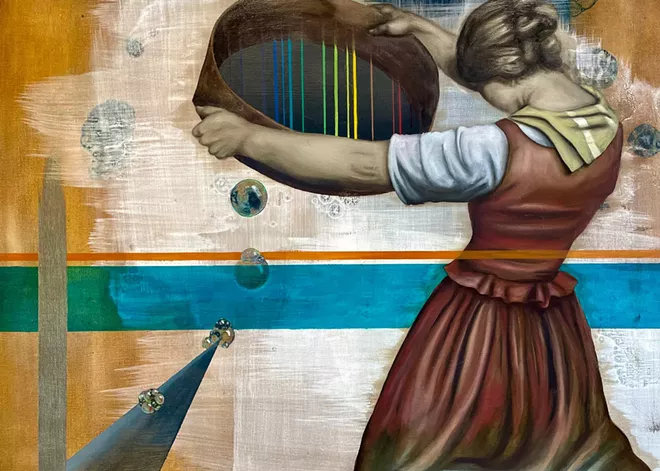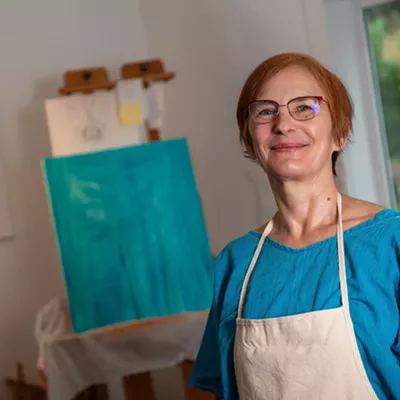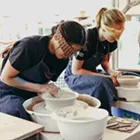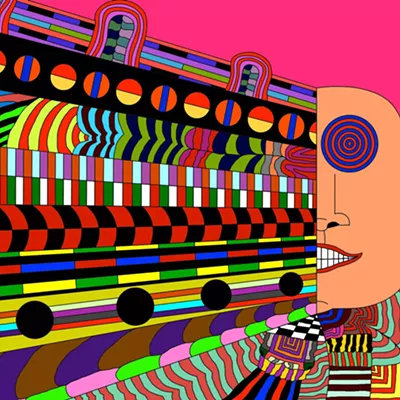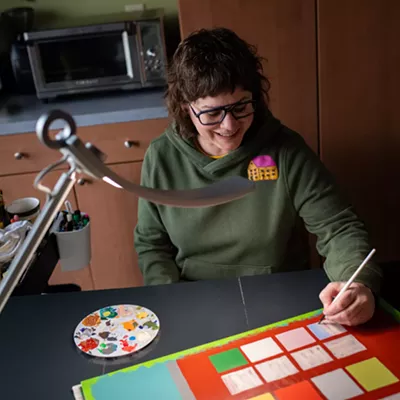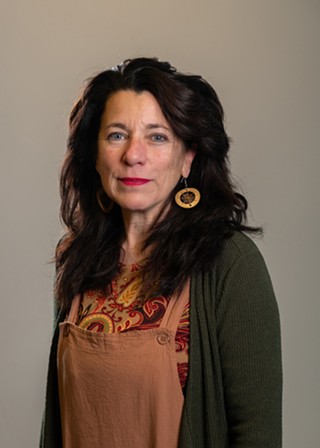In Michelangelo's painting "The Creation of Adam," reclining Adam, his left hand listlessly outstretched, awaits God's animating touch. The famous fresco forms the centerpiece of the Sistine Chapel's ceiling panels, depicting not the birth of humanity, but the moment just before it, according to scholars. And although the slight gap between God's and Adam's hands might not be visible from the chapel floor 68 feet below, its likeness has been immortalized over the centuries, including by artists employing its symbolic potential.
Dustin M. Regul is one of them.
In his mixed media painting "A Seeing Lesson," Regul flips the familiar narrative. Literally. Regul's painting includes a zoomed-in view of God's and Adam's hands, yet reversed so that Adam's is to the right and only one finger, presumably God's, is visible to the left.
Is Regul suggesting that humanity birthed God, not the other way around? Is he representing the view from space versus from the floor of the chapel? Or is there some other meaning?
All good questions, none of which he's inclined to answer, says Regul, whose exhibition "rifts & margins" opens Friday, April 4, at Saranac Art Projects in downtown Spokane. The artist is currently based in Moses Lake, working as a tenure-track art instructor at Big Bend Community College.
"You can probably put all artwork under two categories: one that holds the viewer's hand and one that ends up giving them more questions than answers," Regul says. "So, both of them are valid, but me personally, I was always drawn toward artwork that didn't hold my hand, but posed more questions, got me thinking and never really gave me any specifics on maybe what its intentions were."
In his statement accompanying the exhibition, which runs through April 26, Regul describes how his work "explore[s] the liminal spaces between established reality and undiscovered potential." The known and the unknown; realism and abstraction — and especially the spaces in between two such seemingly opposite things.
"Usually, you tend to make artwork that you like to see," Regul says. The word "liminal" — a threshold, occupying both sides of a boundary, a transition between things — can speak to science and metaphysics, both things he's interested in, but as for what specific images mean, that's open for interpretation.
"Just getting the viewer to take a moment to contemplate or consider what that could be honestly is the ultimate goal here," he says.
Like many artists, Regul's interest in making things was influenced by family members, including those who did cabinetry and woodworking. One of 34 graduating high school seniors in rural Hebron, Illinois, Regul was greatly drawn to the vibe his art teacher created in class.
"I think what drew me to [my teacher] was he was ex-military, but then at the same time, like, he was just the gentlest human being," Regul says.
Regul remembers discovering the writings of Carl Sagan, the eminent American astronomer and planetary scientist whose seminal works include Dragons of Eden and Cosmos.
"It started to pique my curiosity... the amount of things humans know, and the unfathomable amount of things that we don't know," Regul says.
Another pivotal moment in his artistic development involved a 2011 trip to the Mildred Lane Kemper Art Museum in St. Louis, Missouri. There Regul was struck by the synthesis of art and science in the work of contemporary Argentinian-born artist and architect Tomás Saraceno, whose work explored the idea of a "sustainable city in the sky consisting of a series of bubble-like cells fueled by solar energy."
"That was the first time I was like, 'Oh, wait, art can be like this?'" Regul says.
After earning his Bachelor of Arts at Illinois College, Regul pursued his Master of Arts at Eastern Illinois University, followed by a break from school that returned him to woodworking in a big way. He'd heard about Jim Bolin, founder of the Big Things in a Small Town workshop, who'd built the world's largest wind chime in his bid to make his hometown, Casey, Illinois, a tourist attraction.
"And so, like, there was no job posting," says Regul, who nonetheless offered his services. "I was like, 'Hey, um, I got an art degree, and I'm a pretty good carpenter. You want some help?'"
Three years later, Regul had helped fabricate a giant rocking chair, golf tee, mailbox and more, all of which still hold a spot in the Guinness Book of World Records.
In 2019, Regul moved across the country to earn his Master of Fine Arts from Washington State University, which he describes as being more interdisciplinary than similar programs.
In addition to woodworking and painting, Regul has worked with photography, stained glass and sculpture, and he approaches his work with spontaneity.
"Sometimes it's the material itself that 'asks' to be worked with," he says.
Another thing Regul liked about WSU's art program was the level of freedom and encouragement to experiment. In addition to inviting art mentors Joe Hedges and Michael Holloman to serve on his thesis committee, for example, he included Brian Saam, an experimental atomic, molecular and optical physicist, which he says was atypical yet powerful because Saam could see things the artists could not.
As the three artists talked about art, Saam would just listen, Regul recalls.
"But it's like that thing — you can't see the forest through the trees," Regul says, adding that "all of a sudden [Brian] would just say one thing that, after he said it, is just so blatantly obvious what we were missing." ♦
Dustin M. Regul: rifts & margins • April 4-26; Fri-Sat from noon-8 pm • Saranac Art Projects • 25 W. Main Ave. • sapgallery.com • 509-321-9416

